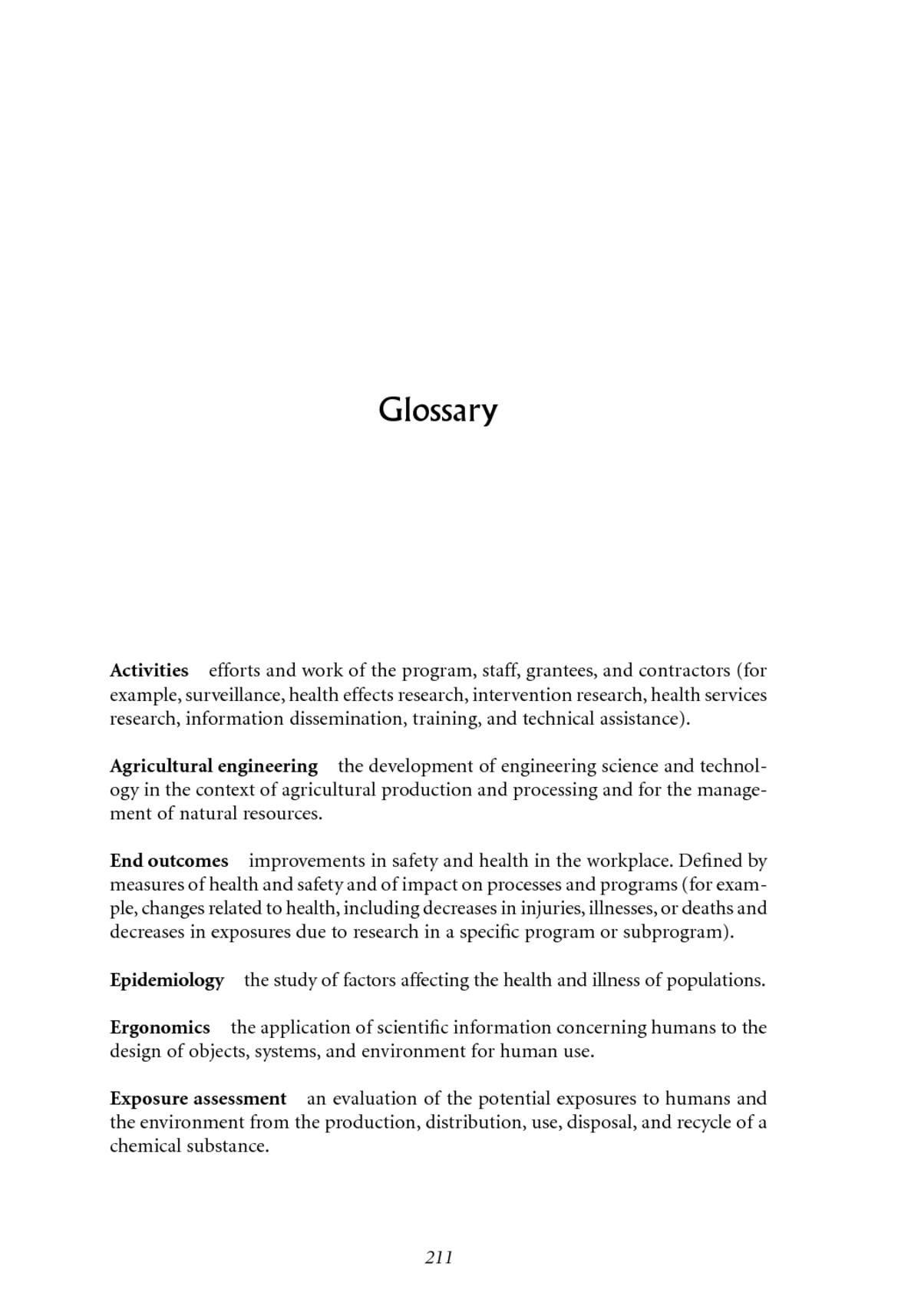


Below is the uncorrected machine-read text of this chapter, intended to provide our own search engines and external engines with highly rich, chapter-representative searchable text of each book. Because it is UNCORRECTED material, please consider the following text as a useful but insufficient proxy for the authoritative book pages.
Glossary Activitiesâ efforts and work of the program, staff, grantees, and contractors (for example, surveillance, health effects research, intervention research, health services research, information dissemination, training, and technical assistance). Agricultural engineeringâ the development of engineering science and technol- ogy in the context of agricultural production and processing and for the manage- ment of natural resources. End outcomesâ improvements in safety and health in the workplace. Defined by measures of health and safety and of impact on processes and programs (for exam- ple, changes related to health, including decreases in injuries, illnesses, or deaths and decreases in exposures due to research in a specific program or subprogram). Epidemiologyâ the study of factors affecting the health and illness of populations. Ergonomicsâ the application of scientific information concerning humans to the design of objects, systems, and environment for human use. Exposure assessmentâ an evaluation of the potential exposures to humans and the environment from the production, distribution, use, disposal, and recycle of a chemical substance. 211
212 A g r i c u lt u r e , F o r e s t r y , and Fishing Research at NIOSH External factorsâ actions or forces beyond NIOSHâs control (for example, by industry, labor, regulators, and other entities) with important bearing on the in- corporation in the workplace of NIOSHâs outputs to enhance safety and health. Extramural researchâ research supported by funds from NIOSH to research- ers and organizations outside NIOSH through a grant, contract, or cooperative agreement. Health effects researchâ research that investigates physical, chemical, and biologic hazards (injuries and exposures, illness, and death). Hired farm workerâ persons that are paid to perform duties on a farm. Farmworkerâ adjective used to describe a noun, such as âfarmworker healthâ or âfarmworker families.â Farm workerâ any person (self-employed, unpaid, or paid) that performs tasks on a farm. Industrial hygieneâ the science of anticipating, recognizing, evaluating, and con- trolling workplace conditions that may cause workersâ injury or illness. Intermediate outcomesâ related to the research programâs association with behav- iors and changes at individual, group, and organization levels in the workplace. An assessment of the worth of NIOSH research and its products by outside stakehold- ers (for example, production of standards or regulations based in whole or in part on NIOSH research; attendance in training and education programs sponsored by other organizations; use of publications, technologies, methods, or recommenda- tions by workers, industry, and occupational safety and health professionals in the field; and citations of NIOSH research by industry and academic scientists). Intervention researchâ includes studies in which researchers arrange (or follow) a systematic change in conditions to determine the effects on a physical capacity, skill, or performance. Intramural researchâ research within NIOSH. Knowledge diffusionâ the adaptation of knowledge in a broad range of scientific and engineering research and development.
Glossary 213 Outputsâ a direct product of a NIOSH research program that is logically related to the achievement of desirable and intended outcomes (for example, publications in peer-reviewed journals, recommendations, reports, Web site content, workshops and presentations, databases, educational materials, scales and methods, new tech- nologies, patents, and technical assistance). Planning inputsâ stakeholder input, surveillance, and intervention data, and risk assessments (for example, input from Federal Advisory Committee Act panels or the National Occupational Research Agenda research partners, intramural surveil- lance information, or health hazard evaluations). Populations at riskâ people that have proximity to the activities of agriculture, forestry, and fishing and to the potential dangers involved in those activities. Production inputsâ intramural and extramural funding, staffing, management structure, and physical facilities. Stakeholderâ individual or party that has an interest in and may be affected by the NIOSH AFF Program. Technology transferâ the process of developing practical applications for the results of scientific research. Surveillanceâ the observation and recording of injuries, illnesses, and deaths. Zoonoses, zoonotic diseasesâ diseases caused by infectious agents that can be transmitted between (or are shared by) animals and humans.
